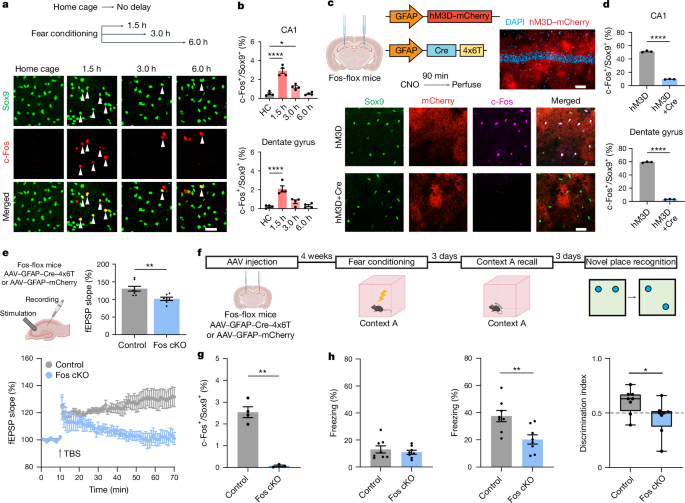Josselyn, S. A. & Tonegawa, S. Memory engrams: recalling the past and imagining the future. Science 367, eaaw4325 (2020).
Liu, X. et al. Optogenetic stimulation of a hippocampal engram activates fear memory recall. Nature 484, 381â385 (2012).
Ramirez, S. et al. Creating a false memory in the hippocampus. Science 341, 387â391 (2013).
Roy, D. S. et al. Brain-wide mapping reveals that engrams for a single memory are distributed across multiple brain regions. Nat. Commun. 13, 1799 (2022).
Han, J.-H. et al. Selective erasure of a fear memory. Science 323, 1492â1496 (2009).
Dallérac, G., Zapata, J. & Rouach, N. Versatile control of synaptic circuits by astrocytes: where, when and how? Nat. Rev. Neurosci. 19, 729â743 (2018).
Kofuji, P. & Araque, A. Astrocytes and behavior. Annu. Rev. Neurosci. 44, 49â67 (2021).
Allen, N. J. & Eroglu, C. Cell biology of astrocyteâsynapse interactions. Neuron 96, 697â708 (2017).
Nagai, J. et al. Behaviorally consequential astrocytic regulation of neural circuits. Neuron 109, 576â596 (2021).
Soto, J. S. et al. Astrocyteâneuron subproteomes and obsessiveâcompulsive disorder mechanisms. Nature 616, 764â773 (2023).
Sardar, D. et al. Induction of astrocytic Slc22a3 regulates sensory processing through histone serotonylation. Science 380, eade0027 (2023).
Cheng, Y.-T. et al. Social deprivation induces astrocytic TRPA1âGABA suppression of hippocampal circuits. Neuron 111, 1301â1315 (2023).
Lawal, O., Ulloa Severino, F. P. & Eroglu, C. The role of astrocyte structural plasticity in regulating neural circuit function and behavior. Glia 70, 1467â1483 (2022).
Fleischmann, A. et al. Impaired long-term memory and NR2A-type NMDA receptor-dependent synaptic plasticity in mice lacking c-Fos in the CNS. J. Neurosci. 23, 9116â9122 (2003).
Katche, C. et al. Delayed wave of c-Fos expression in the dorsal hippocampus involved specifically in persistence of long-term memory storage. Proc. Natl Acad. Sci. USA 107, 349â354 (2010).
Lacagnina, A. F. et al. Distinct hippocampal engrams control extinction and relapse of fear memory. Nat. Neurosci. 22, 753â761 (2019).
Khakh, B. S. & Sofroniew, M. V. Diversity of astrocyte functions and phenotypes in neural circuits. Nat. Neurosci. 18, 942â952 (2015).
Papouin, T., Dunphy, J., Tolman, M., Foley, J. C. & Haydon, P. G. Astrocytic control of synaptic function. Philos. Trans. R. Soc. Lond. B Biol. Sci. 372, 20160154 (2017).
Endo, F. et al. Molecular basis of astrocyte diversity and morphology across the CNS in health and disease. Science 378, eadc9020 (2022).
Kol, A. et al. Astrocytes contribute to remote memory formation by modulating hippocampalâcortical communication during learning. Nat. Neurosci. 23, 1229â1239 (2020).
Cheng, Y.-T. et al. Inhibitory input directs astrocyte morphogenesis through glial GABABR. Nature 617, 369â376 (2023).
Henneberger, C., Papouin, T., Oliet, S. H. R. & Rusakov, D. A. Long-term potentiation depends on release of d-serine from astrocytes. Nature 463, 232â236 (2010).
Huang, A. Y.-S. et al. Region-specific transcriptional control of astrocyte function oversees local circuit activities. Neuron 106, 992â1008 (2020).
Adamsky, A. et al. Astrocytic activation generates de novo neuronal potentiation and memory enhancement. Cell 174, 59â71 (2018).
Suthard, R. L. et al. Basolateral amygdala astrocytes are engaged by the acquisition and expression of a contextual fear memory. J. Neurosci. https://doi.org/10.1523/JNEUROSCI.1775-22.2023 (2023).
Yap, E.-L. & Greenberg, M. E. Activity-regulated transcription: bridging the gap between neural activity and behavior. Neuron 100, 330â348 (2018).
Gleichman, A. J., Kawaguchi, R., Sofroniew, M. V. & Carmichael, S. T. A toolbox of astrocyte-specific, serotype-independent adeno-associated viral vectors using microRNA targeting sequences. Nat. Commun. 14, 7426 (2023).
Sun, W. et al. Spatial transcriptomics reveal neuronâastrocyte synergy in long-term memory. Nature https://doi.org/10.1038/s41586-023-07011-6 (2024).
Chen, M. B., Jiang, X., Quake, S. R. & Südhof, T. C. Persistent transcriptional programmes are associated with remote memory. Nature 587, 437â442 (2020).
Yu, X. et al. Reducing astrocyte calcium signaling in vivo alters striatal microcircuits and causes repetitive behavior. Neuron 99, 1170â1187 (2018).
Ung, K., Tepe, B., Pekarek, B., Arenkiel, B. R. & Deneen, B. Parallel astrocyte calcium signaling modulates olfactory bulb responses. J. Neurosci. Res. 98, 1605â1618 (2020).
Choi, J.-H. et al. Interregional synaptic maps among engram cells underlie memory formation. Science 360, 430â435 (2018).
Park, H. et al. Channel-mediated astrocytic glutamate modulates hippocampal synaptic plasticity by activating postsynaptic NMDA receptors. Mol. Brain 8, 7 (2015).
Yu, X. et al. Context-specific striatal astrocyte molecular responses are phenotypically exploitable. Neuron https://doi.org/10.1016/j.neuron.2020.09.021 (2020).
Lin, C.-C. J. et al. Identification of diverse astrocyte populations and their malignant analogs. Nat. Neurosci. 20, 396â405 (2017).
Morel, L. et al. Molecular and functional properties of regional astrocytes in the adult brain. J. Neurosci. 37, 8706â8717 (2017).
de Ceglia, R. et al. Specialized astrocytes mediate glutamatergic gliotransmission in the CNS. Nature https://doi.org/10.1038/s41586-023-06502-w (2023).
Ghandour, K. et al. Orchestrated ensemble activities constitute a hippocampal memory engram. Nat. Commun. 10, 2637 (2019).
Ung, K. et al. Olfactory bulb astrocytes mediate sensory circuit processing through Sox9 in the mouse brain. Nat. Commun. 12, 5230 (2021).
Rao-Ruiz, P. et al. Engram-specific transcriptome profiling of contextual memory consolidation. Nat. Commun. 10, 2232 (2019).
Lozzi, B., Huang, T.-W., Sardar, D., Huang, A. Y.-S. & Deneen, B. Regionally distinct astrocytes display unique transcription factor profiles in the adult brain. Front. Neurosci. https://doi.org/10.3389/fnins.2020.00061 (2020).
Cheng, Y.-T., Woo, J. & Deneen, B. Sculpting astrocyte diversity through circuits and transcription. Neuroscientist https://doi.org/10.1177/10738584221082620 (2022).
Scavuzzo, M. A. et al. Pancreatic cell fate determination relies on Notch ligand trafficking by NFIA. Cell Rep. 25, 3811â3827 (2018).
Srinivasan, R. et al. Ca2+ signaling in astrocytes from Ip3r2â/â mice in brain slices and during startle responses in vivo. Nat. Neurosci. 18, 708â717 (2015).
Ewels, P., Magnusson, M., Lundin, S. & Käller, M. MultiQC: summarize analysis results for multiple tools and samples in a single report. Bioinformatics 32, 3047â3048 (2016).
Dobin, A. et al. STAR: ultrafast universal RNA-seq aligner. Bioinformatics 29, 15â21 (2013).


